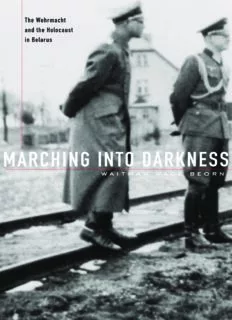
Marching into Darkness: The Wehrmacht and the Holocaust in Belarus PDF
Preview Marching into Darkness: The Wehrmacht and the Holocaust in Belarus
MARCHING INTO DARKNESS MARCHING INTO DARKNESS The Wehrmacht and the Holocaust in Belarus WAITMAN WADE BEORN Harvard University Press Cambridge, Massachusetts • London, England 2014 Copyright © 2014 by the President and Fellows of Harvard College All rights reserved Printed in the United States of America Library of Congress Cataloging- in- Publication Data Beorn, Waitman Wade, 1977– Marching into darkness : the Wehrmacht and the Holocaust in Belarus / Waitman Wade Beorn. pages cm Includes bibliographical references and index. ISBN 978- 0- 674- 72550- 8 1. Jews— Belarus—History—20th century. 2. Holocaust, Jewish (1939–1945)—Belarus—History. 3. World War, 1939– 1945—Atrocities—Belarus. 4. Germany—Armed Forces— History—World War, 1939– 1945. 5. Belarus— Social Conditions—20th century. 6. Belarus— History— German occupation, 1941– 1944. I. Title. DS135.B38B46 2014 940.53'1809478—dc23 2013014774 Contents Introduction 1 1. The Deadliest Place on Earth 27 2. A Weapon of Mass Destruction 38 3. Improvised Murder in Krupki 64 4. Mogilev and the Deliberate Targeting of Jews 92 5. An Evil Seed Is Sown 119 6. Making Genocide Routine 135 7. The Golden Pheasant and the Brewer 151 8. Hunting Jews in Szczuczyn 184 9. Endgame 206 Conclusion 234 Abbreviations 247 Notes 249 Ac know ledg ments 301 Index 305 4 4 3/ 4 19 pr 41- ne 19 D er, d Bor der an Bor v Administrative Germ Postwar Belarusian Krucha Mogile Pripjat Kiev ki up at Kr al-arimir rs eso kommissariatGeneral(Latvia)Lettland R e i c h s - r i a to m m i s s a O s t l a n d General-kommissariatWilnaWeissruthenien BorisovLida Minsk NovogrudokSlonimBaranovichiZyrowice Pripet Marshes kommissariatneralGenVolhyniakommiZhit k ariatnia) yn Ge Riga mmissLithua s Szczucz koGeneralLitauen( Kauna Bialystok ublin Generalovernment at Ostland L G ri a s Nemen man ch Vistula skommis r ei eich e R w R G Warsa ap 1. M 41 R 9 1 e, 1939- S Dnepr Polish Border, 1920-1939 Postwar Belarusian Border Soviet State Borders German-Soviet Demarcation Lin U S Krucha Mogilev R Kiev ! ki S p S u ! Kr n a at ov usi Pripj s ori ar R B nsk Bel SS Mi es n sh a R ar ni SS hi pet M rai an udok novic Pri Uk Latvi Wilna Lida yn NovogrnimBarawice SR s czucz Slo Zyro S na Sz Riga ian Kau blic n u a ok ep Lithu Nemen Bialyst blin ocialist R Lu nt et S erman Reich wVistula Generalvernme Belarusian Sovi G Warsa Go ap 2. M Introduction On a bitterly cold morning in November 1941, Lisa and Pola Nussbaum were brought by their mother to the barbed-w ire fence surrounding the Slonim ghetto in western Belarus. She told them to squeeze through and hide with a neighbor. Lisa and Pola were just four- teen and nineteen years old, yet they had already escaped death at the hands of the Germans several times. Born in a small Polish town on the German border, the two girls had fl ed with their family progressively farther east before being trapped in Slonim by the German advance in 1941.1 Rumors had fl own in the ghetto of an impending massacre. Unable to acquire a work permit that might spare her children, Lisa and Pola’s mother made the heart- wrenching decision to send her girls away. Once through the fence, Lisa and Pola took off their yellow Star of David and ran to the house of a Christian neighbor. Upon hearing that the Nazis were preparing a mass shooting, the neighbor forced the girls to leave. Refused refuge in the town, the two girls fl ed into the harsh Belarusian winter and hid in the nearby woods. In the dark pine forest, they stumbled across the meadow where the Jews of Slonim were being murdered. There, around ten thousand Jewish men, women, and chil- dren w ere forced to sit in groups, guarded by German soldiers. In groups 1
Description: